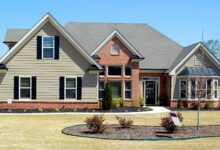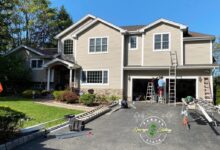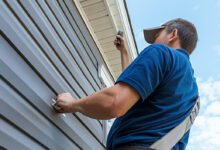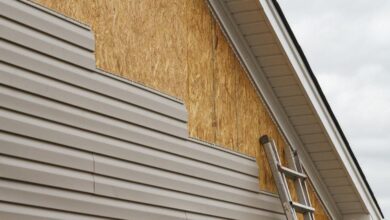Siding Repair Near Me: A Comprehensive Guide
Siding repair near me is a crucial consideration for homeowners facing exterior damage. This guide delves into the common concerns, from identifying damage types to finding reputable contractors. We’ll explore various siding materials, repair processes, cost estimations, and visual examples to help you navigate the repair journey successfully. Understanding the local demand for these services, including the frequency of requests for different materials like vinyl, wood, and fiber cement, is essential for informed decision-making. Proper preparation and cleanup are equally important to ensure a seamless and lasting repair.
We will examine the factors influencing repair needs, such as age, weather conditions, and preventative maintenance. The guide will also provide practical advice on selecting a contractor, emphasizing the importance of licensing, insurance, and obtaining multiple quotes. This will empower you to make well-informed choices that ensure both quality workmanship and cost-effectiveness.
Understanding Local Demand for Siding Repair
Homeowners often face unexpected siding issues, leading to a consistent demand for repair services. Understanding the common concerns and damage types is crucial for siding contractors to effectively serve their local market. This understanding allows for better resource allocation and targeted marketing efforts.
Homeowners are primarily concerned with protecting their homes from the elements and maintaining their property value. Siding damage not only compromises the structural integrity of the house but also significantly impacts its curb appeal, leading to decreased property value and potential safety hazards. Repair needs are therefore driven by a combination of functional and aesthetic considerations.
Typical Homeowner Concerns Related to Siding Damage
The most frequent concerns expressed by homeowners regarding siding damage revolve around water intrusion, which can lead to mold, rot, and structural damage. They also worry about the appearance of their home, with damage like cracks, discoloration, and loose or missing siding significantly impacting curb appeal. Energy efficiency is another concern, as damaged siding can lead to increased energy costs due to drafts and heat loss. Finally, homeowners are naturally concerned about the cost of repairs and the disruption caused by the repair process.
Common Types of Siding Damage Found in Different Climates
Siding damage varies significantly based on local climate conditions. In areas with harsh winters, ice dams and freeze-thaw cycles can cause cracking and buckling, particularly in wood and vinyl siding. Coastal regions often experience damage from salt spray, leading to corrosion and premature deterioration of metal and wood siding. Areas prone to high winds may see damage from impact from debris, while regions with intense sun exposure experience fading and warping, especially with vinyl and wood siding. For example, a home in a hurricane-prone area might require frequent repairs due to wind damage, whereas a home in a snowy climate might experience more issues related to ice buildup and moisture damage.
Frequency of Repair Requests for Various Siding Materials
Vinyl siding, due to its affordability and ease of installation, is the most common type installed, resulting in a high volume of repair requests. However, vinyl siding is susceptible to cracking and fading, particularly in harsh climates. Wood siding, while aesthetically pleasing, requires more frequent maintenance and repairs due to its susceptibility to rot, insect infestation, and weathering. Fiber cement siding is a more durable option, requiring fewer repairs over its lifespan, although it is more expensive upfront. Metal siding is also quite durable, but damage from hail or impacts can necessitate repairs. The frequency of repair requests therefore directly correlates with the material’s durability and susceptibility to environmental factors.
Factors Influencing the Need for Siding Repair
Several factors significantly influence the need for siding repair. The age of the siding is a major factor; older siding is more likely to show signs of wear and tear. Weather conditions, including extreme temperatures, heavy rainfall, strong winds, and hail, can all contribute to siding damage. Neglect, such as failing to address minor damage promptly, can allow small problems to escalate into larger, more costly repairs. For instance, a small crack in vinyl siding, if left unaddressed, could allow water intrusion, leading to rot in underlying sheathing and requiring extensive repairs. Proper maintenance and timely repairs can significantly extend the lifespan of siding and reduce the frequency of needed repairs.
Finding and Evaluating Local Siding Repair Businesses
Choosing the right siding repair business is crucial for ensuring a quality repair and protecting your home’s exterior. A thorough evaluation process, considering various factors, will lead to a successful project and prevent costly mistakes down the line. This section will guide you through the steps involved in finding and evaluating reputable local siding repair companies.
Local Siding Repair Company Pricing Structures
Understanding the pricing structures of different siding repair companies is essential for budget planning. Prices vary significantly depending on factors such as the extent of damage, the type of siding, the company’s overhead, and their experience. Below is a sample comparison, remember to always obtain personalized quotes based on your specific needs.
| Company Name | Service Offered | Price Range | Customer Reviews |
|---|---|---|---|
| ABC Siding Solutions | Vinyl Siding Repair, Replacement | $500 – $3000 per project | 4.5 stars (based on 50 reviews) – Mostly positive comments regarding professionalism and quality of work. Some complaints about scheduling delays. |
| Best Siding Repair | Wood Siding Repair, Fiber Cement Repair | $700 – $5000 per project | 4 stars (based on 100 reviews) – High praise for craftsmanship, but some concerns about communication and responsiveness. |
| Quality Siding Pros | All Siding Types, Insurance Claims Assistance | $600 – $4000 per project | 4.2 stars (based on 75 reviews) – Generally positive feedback, but a few instances of minor issues with cleanup. |
| Affordable Siding Repair | Vinyl Siding Repair, Small Repairs | $200 – $1500 per project | 3.8 stars (based on 20 reviews) – Lower price point reflects a smaller scope of work and potentially less experience. |
Effective Marketing Strategies of Successful Siding Repair Businesses
Successful siding repair businesses often employ a multi-pronged marketing approach to reach potential clients. This typically involves a combination of online and offline strategies.
Examples include targeted online advertising through Google Ads and social media marketing on platforms like Facebook and Instagram. They often utilize professional photography showcasing their high-quality work. Offline strategies may include local print advertising in community newspapers or flyers distributed in neighborhoods. Building relationships with real estate agents and insurance adjusters can also generate a significant amount of business. Strong online reviews and testimonials are also crucial.
Licensing and Insurance for Reputable Siding Repair Contractors
Licensing and insurance are vital indicators of a reputable siding repair contractor. A valid contractor’s license demonstrates compliance with local regulations and a commitment to professional standards. General liability insurance protects homeowners from financial losses in case of accidents or property damage during the repair process. Workers’ compensation insurance protects employees in case of on-the-job injuries. Checking these credentials provides peace of mind and legal protection.
Benefits of Obtaining Multiple Quotes Before Choosing a Contractor
Getting multiple quotes from different siding repair companies allows for a comprehensive comparison of pricing, services offered, and overall value. This process enables informed decision-making, ensuring you choose the contractor best suited to your needs and budget. Comparing quotes highlights potential discrepancies in pricing and service offerings, allowing you to negotiate and secure the most favorable terms. This proactive approach minimizes the risk of overspending or encountering unforeseen issues during the project.
The Siding Repair Process
Repairing your siding involves a methodical approach to ensure a lasting and aesthetically pleasing result. Understanding the process, from initial assessment to final cleanup, is crucial for homeowners to effectively manage repairs or choose a reliable contractor. This section outlines the typical steps involved in a siding repair project.
Siding Damage Assessment
A thorough inspection is the first step in any siding repair. This involves carefully examining the entire siding surface for damage, including cracks, holes, loose panels, water damage, and signs of insect infestation. The type and extent of damage will dictate the necessary repair strategy. For example, a small crack might only require caulking, while significant water damage may necessitate panel replacement. Detailed photographic documentation of the damage is beneficial for both the homeowner and the contractor.
Material Selection
Choosing the right materials is paramount for a successful repair. The selected materials should match the existing siding in color, texture, and material type. Using mismatched materials will be noticeable and detract from the overall appearance of the home. When replacing panels, ensure the new panels are from the same manufacturer and batch as the existing siding whenever possible to minimize color variations. For caulking, choose a high-quality, weather-resistant sealant appropriate for exterior use.
Siding Repair Methods
Different types of siding damage require different repair methods. Crack repair, for instance, often involves cleaning the crack, applying a compatible sealant, and then painting over the repaired area to match the surrounding siding. Panel replacement involves carefully removing the damaged panel, installing a new one, and ensuring proper alignment and fastening. Caulking is used to seal gaps and cracks around windows, doors, and other areas where siding meets other building components. More extensive damage, such as significant water damage or insect infestation, may require more extensive repairs or even complete siding replacement.
Repair Installation
The installation process varies depending on the type of siding and the specific repair. However, the general principles remain the same: careful preparation, precise measurements, secure fastening, and attention to detail. For example, when replacing a panel, the surrounding panels may need to be temporarily removed to allow for easy access and proper installation. After the new panel is installed, it should be securely fastened to the underlying structure. All fasteners should be appropriately concealed.
Proper Preparation and Cleanup
Proper preparation is key to a successful repair. This includes protecting surrounding areas with drop cloths or other protective coverings to prevent damage during the repair process. All loose or damaged materials should be carefully removed and disposed of properly. After the repair is complete, a thorough cleanup is essential. This includes removing all debris, disposing of waste materials, and ensuring the work area is left clean and tidy.
Flowchart Illustrating Siding Repair Stages
A simple flowchart illustrating the stages would look like this:
[Imagine a flowchart here. The boxes would read: 1. Damage Assessment; 2. Material Selection; 3. Repair Method Selection; 4. Repair Installation; 5. Cleanup and Inspection.] The arrows would connect each stage sequentially. This visual representation clearly shows the linear progression of the repair process.
Materials and Costs Associated with Siding Repair
Understanding the costs involved in siding repair is crucial for budgeting and making informed decisions. The total expense depends heavily on the type of siding, the extent of the damage, and the labor required. This section breaks down the various cost factors to help you prepare for your project.
Different siding materials vary significantly in price and longevity. Vinyl siding, a popular and affordable choice, typically costs between $2 and $8 per square foot, offering a lifespan of 20-30 years. Fiber cement siding, known for its durability and fire resistance, ranges from $6 to $12 per square foot and can last 50 years or more. Wood siding, while aesthetically pleasing, is more expensive, costing between $8 and $20 per square foot, and requires more frequent maintenance. Metal siding, another durable option, generally falls within the $6 to $15 per square foot range, boasting a lifespan comparable to fiber cement. The initial cost difference is often offset by the material’s longevity and reduced maintenance needs over time.
Factors Influencing Overall Siding Repair Costs
Several factors contribute to the overall cost of a siding repair project. Material costs, as discussed above, are a significant component. Labor costs are equally important, varying based on the complexity of the repair, the contractor’s experience, and local labor rates. A simple repair might only require a few hours of labor, while extensive damage could necessitate several days of work. The complexity of the repair itself also impacts the final cost; repairing a small section of damaged siding is considerably cheaper than replacing a large area or dealing with underlying structural issues. For example, replacing a single damaged panel might cost a few hundred dollars, while repairing extensive storm damage could easily reach several thousand.
Common Additional Costs Associated with Siding Repair
Beyond the primary costs of materials and labor, several additional expenses can arise during a siding repair project. It’s important to factor these into your budget to avoid unexpected financial burdens.
- Permits: Many localities require permits for significant home repairs, including siding replacement or extensive repairs. Permit fees vary depending on location and the scope of the project.
- Disposal Fees: Removing and disposing of old siding materials often incurs additional costs. These fees vary based on the volume of waste and local regulations.
- Scaffolding/Equipment Rental: For larger projects or difficult-to-reach areas, scaffolding or specialized equipment may be necessary, adding to the overall expense.
- Matching Existing Siding: Finding a perfect match for existing siding, especially for older homes, can be challenging and may increase material costs.
- Unexpected Repairs: During the repair process, unforeseen damage might be discovered, leading to additional costs for materials and labor.
Calculating a Realistic Budget for Siding Repair
Creating a realistic budget involves careful consideration of all cost components. Begin by obtaining estimates from multiple contractors. Compare their quotes, ensuring they detail all materials and labor costs, as well as any potential additional expenses.
To calculate a realistic budget, add the estimated costs of materials, labor, and all potential additional expenses. Add a contingency buffer of 10-20% to account for unforeseen issues. For example, if the estimated cost is $2000, add $200-$400 as a contingency. This will help prevent cost overruns.
Visual Representation of Siding Repair
Understanding the visual aspects of siding damage and repair is crucial for homeowners to assess the extent of the problem and to evaluate the quality of repair work. This section will detail the appearance of common siding issues and illustrate the visual improvements achieved through professional repair.
Different types of siding damage present distinct visual characteristics. Careful observation can help identify the cause and guide repair decisions.
Siding Damage Types and Their Visual Appearance
Water damage often manifests as discoloration, particularly dark streaks or stains, usually along seams or at the bottom of siding panels. The affected areas might show signs of swelling or warping, altering the flat surface texture and creating unevenness. Severe water damage can lead to rot, resulting in soft, spongy areas that easily crumble when touched. Color changes can range from subtle darkening to significant fading, depending on the material and the extent of water exposure.
Insect infestation can cause significant damage, often unseen until significant structural weaknesses appear. Tiny holes may be visible on the surface, and wood-boring insects can create tunnels beneath the surface, weakening the siding and leading to buckling or collapse. Evidence of sawdust or insect frass (excrement) near the affected areas is a strong indicator of infestation. The texture of the affected siding might feel spongy or unusually brittle.
Impact damage, such as that caused by hail or falling debris, is characterized by dents, cracks, or holes in the siding. The damage is usually localized, but the severity can vary. Minor dents might only slightly alter the surface texture, while more significant impacts can create large cracks or holes that compromise the structural integrity of the siding. The color of the affected area may be altered due to cracking or surface abrasion.
Examples of Successful Siding Repairs (Before and After)
Imagine a house with noticeable water damage on its vinyl siding. Before repair, dark streaks are evident on several panels near the ground, with some warping visible. The affected areas are noticeably darker than the rest of the siding. After repair, these panels have been replaced with new, matching vinyl siding. The dark streaks are gone, the surface is smooth and even, and the repaired section blends seamlessly with the existing siding, restoring the home’s uniform appearance. The color consistency is perfect.
Consider another scenario: a house with significant hail damage. Before repair, numerous small dents and cracks mar the surface of the aluminum siding. The overall appearance is marred and unprofessional. After repair, the damaged panels are replaced, restoring the smooth, flat surface. The repaired sections are virtually indistinguishable from the undamaged areas, showcasing the importance of color matching. The home’s exterior is restored to its original pristine condition.
Importance of Matching New Siding Materials to Existing Siding
Matching new siding materials to existing siding is paramount for achieving a seamless and aesthetically pleasing repair. Using materials that closely match the color, texture, and profile of the existing siding ensures that the repaired area blends seamlessly with the rest of the exterior. A mismatch can create an unsightly and unprofessional appearance, detracting from the home’s overall curb appeal. For instance, replacing a section of weathered cedar siding with new, bright cedar will immediately stand out, whereas using reclaimed or similarly aged cedar will ensure a natural and invisible repair. This careful attention to detail is essential for maintaining the home’s visual integrity.
Last Word
Ultimately, addressing siding repair near you effectively requires a combination of informed decision-making and careful execution. By understanding the common challenges, selecting a qualified contractor, and planning a realistic budget, you can safeguard your home’s exterior and enhance its curb appeal. Remember that preventative maintenance and prompt attention to minor issues can often prevent more extensive and costly repairs down the line. This comprehensive guide has equipped you with the knowledge to navigate the process confidently and achieve lasting results.







